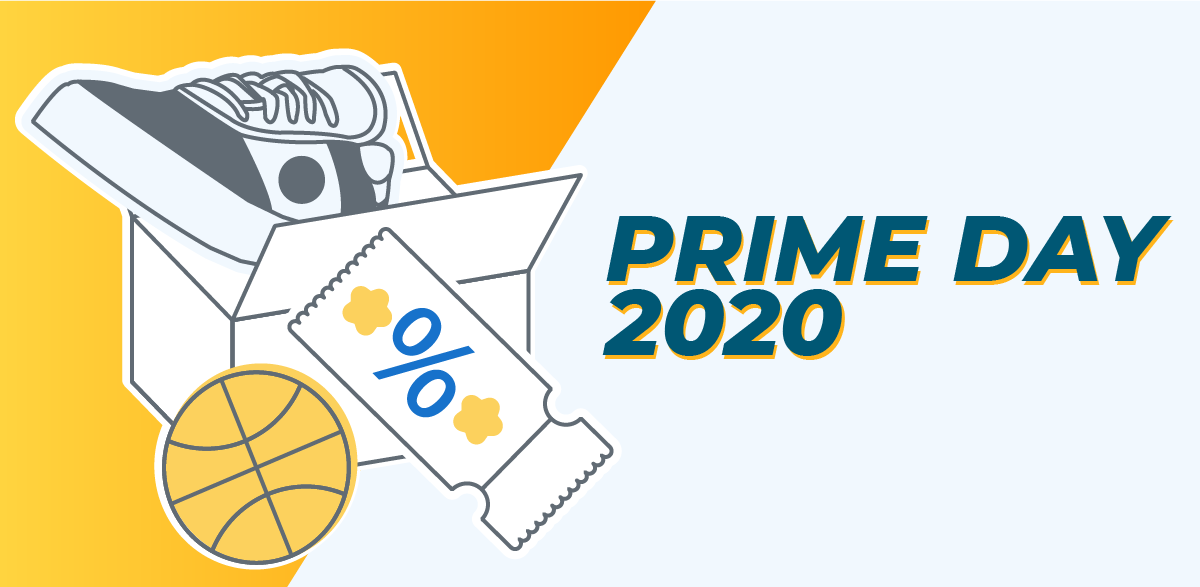
How to Sell on Amazon Prime Day — The Definitive Guide (for Sellers & Vendors)
Robin Hanna, May 6, 2019
Under normal circumstances, Amazon Prime Day would already be behind us, as it usually falls in mid-July.
Promising major discounts on some of Amazon’s most coveted products - Prime members come prepared to spend during the (now) 48-hour sale blitz.
And, they do.
Reliably one of the best days of the year for Amazon sales, predictions for Prime Day usually include a substantial YoY growth. Sales increased by 3 billion dollars between 2018 and 2019, which is more than the entirety of sales in 2017, and the two first years combined.
But for the first time since its inception, Prime Day will be postponed until fall. At long last, Amazon has confirmed that the event will take place on October 13th and 14th, 2020.
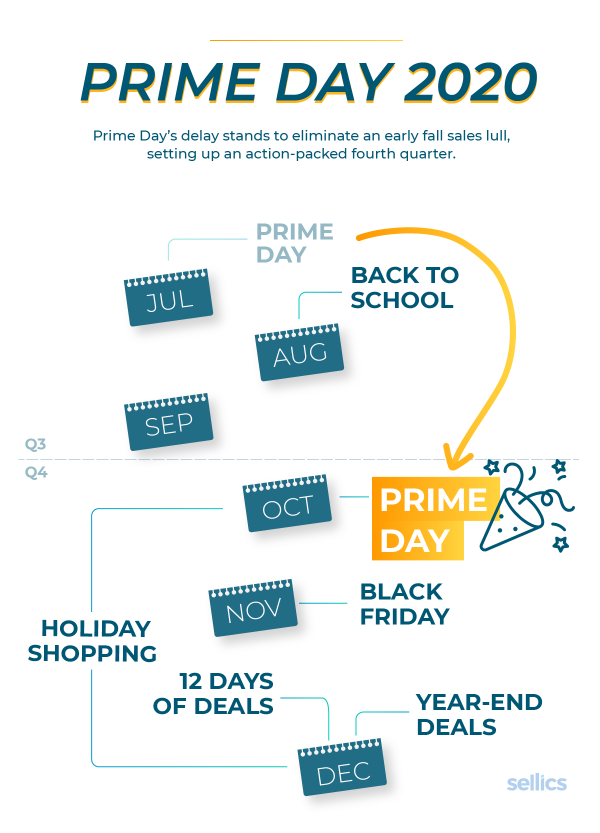
How this will affect the shopping holiday dubbed “Christmas in July” remains to be seen though one thing remains certain: Prime Day represents a tremendous opportunity for selling.
Unsurprisingly, Prime Day promotions are expensive. Maybe you've never participated in Prime Day because your margins wouldn't support the elevated ad spend.
But what if you could learn how to sell on Amazon Prime Day to make a substantial profit — and more than double your sales?
In this guide, we reveal how you can prepare for Prime Day 2020 and make the most of the ‘halo effect' that will magnify your conversions for weeks to come.
Looking for more Amazon PPC background, data, and insights?
Whether you’re interested in a high-level analysis of Amazon Advertising, a detailed look at recent marketplace trends, or a deep dive into the nuances of specific product categories, our 2022 Amazon Advertising Benchmark Report can help you gain insight into the Amazon PPC landscape.
The report is based on a comprehensive analysis of over 2 million Sponsored Products campaigns and you can download it for free today.
How to Sell on Amazon Prime Day — Everything You Need to Know
Hang on - are you here for PPC best practices?
Skip ahead to the results of our Amazon Prime Day PPC Study to learn what you can expect before, on, and after Prime Day and how to adjust your strategy accordingly.
TLDR — The most important information at a glance:
What Is Prime Day?
Launched in 2015, Prime Day is a shopping event exclusive to Amazon Prime members.
Usually, it takes place in July, commemorating the platform’s founding date in 1995. Openly promoted as a pendant to Black Friday, every Prime Day consistently broke the sales record of the previous year.
What Day Is Prime Day 2020?
It is normal for Amazon to keep the exact day a secret and only reveal the date a few days in advance. That said, this year there’s some additional uncertainty as Prime Day is delayed from its typical mid-July schedule.
We can finally say with certainty that Prime Day will take place at the outset of Q4, on October 13th and 14th.
How Long Is Prime Day (2020)?
In 2018, Amazon extended Prime Day from 24 to 36 hours for the first time.
As in 2019, in 2020 Prime Day will run for 48 hours.
At any rate, the lines are blurry here: Sellers will create deals for the weeks before and after Prime Day, making it a month stuffed with bargains.

Benefits for Sellers & Vendors — Is Prime Day Really Worth It?
Promoting your product to an exclusive and shopping-friendly crowd on one of the most anticipated e-commerce events of the year comes with an impressive price tag.
Prime Day was free for the first two years, but in 2017, Amazon introduced a registration fee of $500 per Lightning Deal which increased to $750 in 2018.
The intimidating cost of Prime Day Lightning Deals might dishearten sellers who worry if the performance of their products can sustain such an expense.
In fact, this might be a reason for the fee in the first place: a higher cost will cause Sellers to be more deliberate with their promotions — thus increasing the overall quality of Lightning Deals on Prime Day.
Prime Day breaks sales records every year, so the increase in traffic, sales, and exposure may well justify the initial investment.
Check out this video for a behind-the-scenes look at the logistical challenges presented by hosting a 1-day shopping event — across several timezones!
Even if you can afford the sought-after promotion, your product must fulfill certain criteria to be eligible for a Prime Day Lightning Deal.
If you can’t submit your product, don’t worry — there are many more ways to cash in on the purchasing power of Prime Day.
Let’s take a look at your options.
Prepare for Prime Day 2020 — Tips & Procedures for Sellers & Vendors
Create Bargain Discounts: Amazon Deals, Coupons, and Prime Day Promotion
Prime Day Lightning Deals
Lightning Deals are promotions that appear prominently on the Amazon Deals page for a limited time, usually around four hours.
Lightning Deals are expensive — are they worth the investment?
Sellers who offer Lightning Deals typically experience a noticeable sales boost — especially on Prime Day, when Amazon turns its own marketing machine towards these eye-catching, scarcity-inducing bargains.
Submitting a Lightning Deal doesn’t guarantee that your promotion will be displayed, however.
With the help of an algorithm, Amazon determines the best deals out of the pool of submissions and ranks them according to sales potential.
Deals with the best price, quantity, and inventory are then awarded the best time and position on the Amazon Deals page.
Amazon Lightning Deals: Minimum Requirements for Sellers
Not every seller can take advantage of Lightning Deals. In order to be considered, you must fulfill the following requirements:
Professional Seller Account
At least 5 Seller Feedback Ratings per month
Overall Feedback Rating of at least 3.5 stars

Seller Central: Prime Day eligibility criteria
On top of that, you must also offer products that are eligible for Lightning Deals.
You can easily find out whether your products qualify or not by checking for recommendations on your Lightning Deal dashboard.
If you cannot see any recommendations, then your products are not eligible.
Amazon Lightning Deals: Minimum Requirements for Vendors
Average customer review rating of at least 3 stars
Retail offer must be active
Meets projected customer demand threshold
Discounted price is- at least 20% off the current Amazon retail website price- at least 5% lower than the lowest price in the past 28 days- the lowest price as of January 1st
What Is Amazon Per-Unit Funding?
As a vendor, you are responsible for agreeing on promotional funding with Amazon. That means you decide on a so-called “per-unit funding” that is added to the Base Merchandising Fee ($750 per Lightning Deal on Prime Day).
For example:
If 100 units sell during the promotion and you agreed on a funding amount of $2 per unit, the cost to you will be $200. If no units were sold, your cost is $0.
To help you plan your budget, you can also agree on a “max unit quantity”, i.e. the maximum number of units you want to provide funding for. Using the above example, if you agree to fund 100 units a funding amount of $2 per unit, your maximum cost will be $200.
Don’t have a product eligible for Prime Day? Missed the deadline for Lightning Deals? No problem!
Here are some tips to profit from the generous Prime Day traffic.
Amazon Coupons
Amazon Coupons are a great way to grab the attention of a bargain-hunting Prime Day shopper.
Buyers might be so focussed on finding cheap deals that they skim straight past products without the Lightning Deal label.
Coupons tag each product with an unmistakable discount label, guaranteeing visibility on every page and granting customers a discount of your choice.
In addition, the bright orange coupon labels also decorate your Sponsored Products ads, so you can make your discounted product even more conspicuous if you promote it.
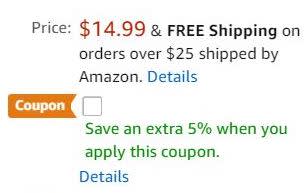
Amazon shoppers can discover coupons:
in their search results
on product pages
in their shopping cart
on the Offer Listings page
in your Brand Store
in your Sponsored Products ads
Good to know for Prime Day: A coupon will only become active two days after you created it — at the earliest. Set a reminder for the last week of September.
Put your best foot forward
The shopping frenzy of Prime Day might tempt you to shift slow-moving stock, rescue inventory from looming long-term fees, or boost sales on a poor-performing product.
Our recommendation: Don't. Prime day is not a magic bullet that will save these shelf warmers. Instead, focus on optimizing and promoting your well-performing products.
They will receive much more visibility and sell better, thus increasing your ROI and improving your sales rank on Amazon.
Deal of the Day
Only for Vendors. Like Lightning Deals, ‘Deal of the Day' promotions feature prominently on the Amazon Deals page, but they run for 24h instead of just a few hours.
On normal days, they are often the first deal a shopper will see — on Prime Day, there’s a good chance that bargain-hungry buyers will go for a ‘Deal of the Day' as well.
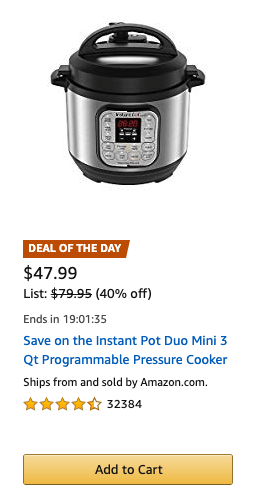
Prime Day Seller Best Practices — How Sellers & Vendors Can Exploit the Full Potential of One of the Year's Biggest Shopping Events
Get ready for Prime Day �— Audit your best-selling listings
Since your focus is on your showrunners, make sure they shine bright.
Check if your titles, bullets, images, and descriptions are up to date — vendors in particular encounter changes without approval on a regular basis.
The Sellics Vendor Edition enables you to easily identify any optimization potential across your product selection: The Content & SEO module offers you an automatic and detailed content analysis.
As part of this module, the Content Monitoring feature gives you a bird’s eye view of any unauthorized changes to your listings.

As a Seller, you will find a similar tool to optimize and track your keyword rankings in the Seller Edition.
Show Your Customers Some Love
Of course, you care about customer feedback — make sure that everyone sees it. Manage negative reviews and answer any open questions.
You should react to negative feedback as fast as possible.
Sellics will instantly notify you about new reviews, so you don’t need to check manually anymore.
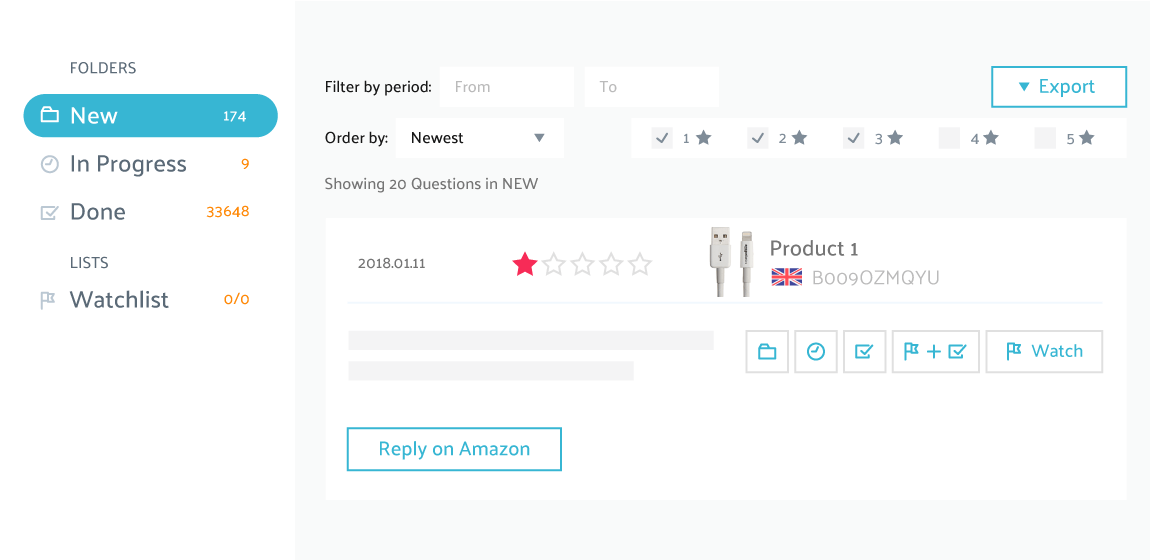
Enhance Your Listing with Amazon’s Brand Features
Vendors and Sellers with a registered brand on Amazon can make use of the increasingly powerful visual content, like Amazon Brand Stores, A+ Content (Vendors) and Enhanced Brand Content (Sellers).
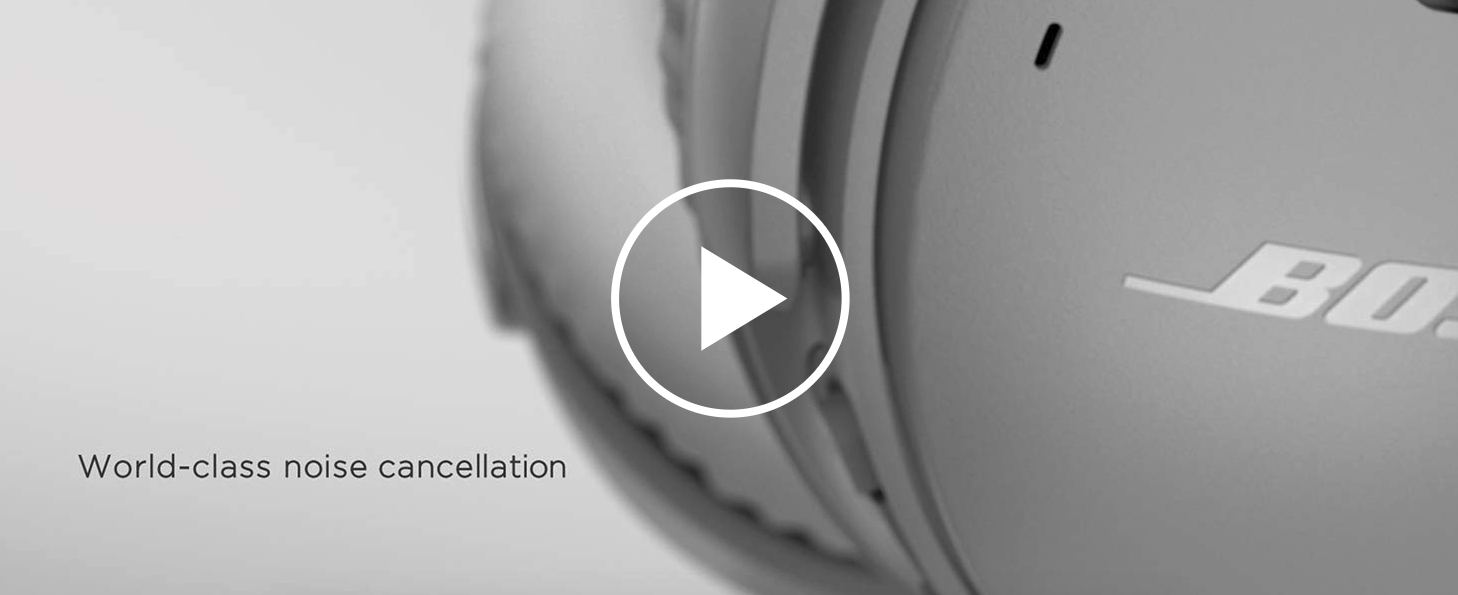
Use the time until Prime Day by fleshing out your listings — and don't forget about video!
The Sellics VE Content & SEO module will show you which of your listings already have A+ Content (and which don’t).
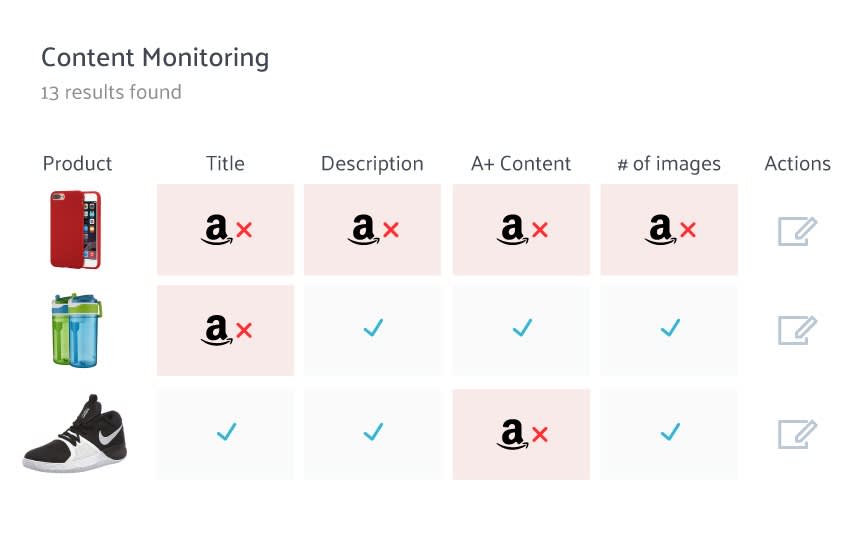
Amazon PPC Performance on Prime Day - What to Expect
In order to make the most of Prime Day 2020, you'll need to know what to expect.
To ensure you can optimize your PPC campaigns to make the best of the shopping frenzy, we reviewed and interpreted data from Amazon Prime Day 2019.
The Data: Advertising Performance in the 3 Months Around Prime Day
Our analysis is based on anonymized Sponsored Products performance data from close to 10,000 US advertiser profiles managed with Sellics. The trends and figures included do not represent an official performance statement of Amazon Advertising. The experiences of some Amazon advertisers may differ.
We looked at data with the following advertising information:
Ad spend
Sales (number of orders & value)
Click-through-rate (CTR)
Conversion rate (CR)
Cost-per-click (CPC)
Return-on-Advertising-Spend (ROAS)
Average selling price (ASP)
We analyzed the weeks leading up to Amazon Prime Day 2019 as well as the ‘two days of Prime’ (July 15, 16) and the days after (3 months in total).
As a result, we can now provide you with the learnings and insights you need to develop an effective PPC advertising strategy to increase your Amazon sales during Black Friday and throughout Cyber Week.
The Findings: Clicks Are More Expensive, but the Higher Ad Spend Still Pays Off
The data shows: Don’t be afraid to increase your ad spend, even if the competition is fierce. Below, we explain this discovery based on four trends we identified in the Amazon Prime Day data.
1. Revenue Growth Surpasses Even Significant Increase in Ad Spend
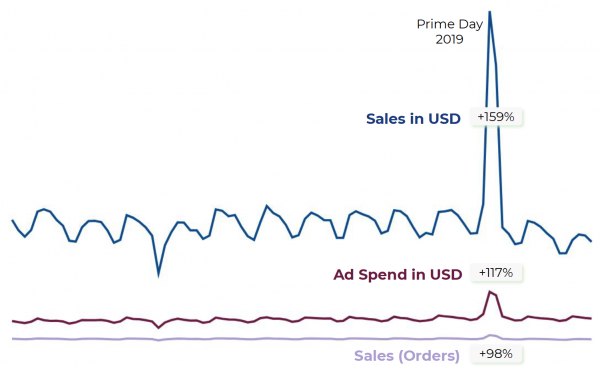
Sales in USD versus Ad Spend of Sellics users on Amazon Prime Day 2019
Looking at the ad spend over this period, your heart might skip a beat. Amazon retailers increased their PPC spend almost 2.2 times for Prime Day 2019 compared to the weeks before.
The number of orders, however, also increased (+98%) and, significantly, advertising sales (in USD) increased almost 2.6 times (+159%) — thus thoroughly outpacing the 2.2X increase in ad spend.
The fact that sales revenue (in USD) increased more than the number of orders indicates that shoppers seem to purchase more expensive items during Amazon Prime Day (see below for more on this).
2. ROAS increases significantly despite a considerable rise in Cost-per-Click
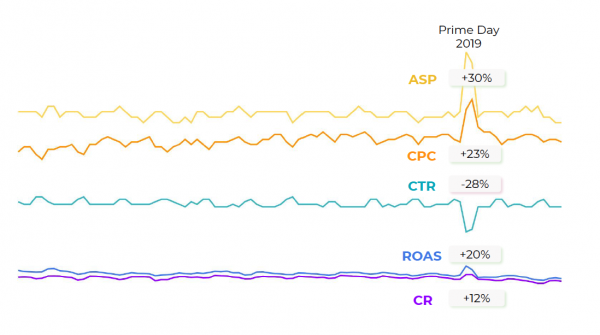
All the PPC metrics of Sellics users for Amazon Prime Day 2019
You may notice another adrenaline-inducing, steep increase of CPCs during the 48 hours of Prime Day (+23%). Ads were more expensive — the upwards CPC trend was, however, offset by a significant increase in ROAS (+20%), meaning the ads delivered better returns. A better ROAS means that you get more return for every dollar you spend on ads.
An improved conversion rate could be an obvious explanation for this interplay. Indeed, overall CR increased during the shopping frenzy (+12%), but not enough to offset the increase in CPC. So we also have to look elsewhere.
The answer lies in the ASP (average selling price). The significant increase in ASP (+30%) is the main reason for the high ROAS. So shoppers indeed tend to buy more expensive products on Prime Day compared to other days.
3. Click-through rates are down!?

CTR values of Sellics users for Amazon Prime Day 2019
You probably didn’t expect this, but CTR actually dropped significantly during Amazon Prime Day in 2019 (-28%).
We developed two hypotheses to make sense of this phenomenon:
More visits on product detail pages: Since shoppers are looking to purchase more expensive items, they spend more time browsing product detail pages to reach a decision. This can negatively affect CTRs because CTRs on product detail pages are usually lower than on other ad placements.
Deal hunting/window shopping: Shoppers browse through the list of Amazon Prime Day deals and specials or search results either because they don’t want to miss a good bargain or they are not entirely sure what they are looking for. This means they spend more time browsing the search results and deal pages, thus creating significantly more ad impressions compared to clicks.
4. ROAS shows signs of shoppers’ fatigue post-Prime Day

Shoppers get more careful and ROAS drops below average after Amazon Prime Day 2019
People have just spent their hard-earned savings on special deals and offers and are less likely to keep shopping now that everything’s back to normal. This so-called shoppers’ fatigue is so strong that the average ROAS is lower after Prime Day than it was before it (-15%). Reviewing the previous diagram, we can see that a lower-than-average CR and a drop in overall sales cause the decrease in ROAS.
Study Summary: Amazon Advertising Tips for Prime Day 2020
The insights from Prime Day point towards clear PPC advertising best practices to make the most of Prime Day 2020:
Focus your Prime Day PPC campaigns on your more expensive products.
Do not hesitate to increase your PPC budgets and bids; the increased conversion rate and increased interest in more expensive products will probably still bring you a favourable ROAS, especially if you sell items with a higher price point.
Once Prime Day is over, reduce your bids and monitor your CR and other PPC metrics closely for at least two weeks to not get caught in shoppers’ fatigue.
Boost Prime Day Visibility With an Informed PPC Strategy
Based on the findings of our study, we recommend that you use Amazon Advertising, especially Sponsored Products and Sponsored Brands, to drive as much traffic as possible to your discounted products and deals on Prime Day.
Remember:
Your Sponsored Products ads will draw additional attention to your Prime Day offers because they will bear the distinct labelling of Lightning Deals and Coupons.
1 — Increase your Prime Day advertising budgets and bids
You will face fierce competition on Prime Day, so it’s time to show your claws and get aggressive — raise your bids.
Remember that the increased conversion rate and heightened interest in more expensive products are likely to turn into a favorable RoAS, especially if you sell items with a higher price point.
That also means it's a good idea to focus your Prime Day PPC campaigns on your more expensive products - since Prime Day is likely to have the highest ASP of the year.
2 — Make use of the new dynamic bidding strategies and the option to adjust your bids by placement
Consider setting your bidding strategy to Up and Down. Amazon will increase your (new) default bid if a click is likely to convert.
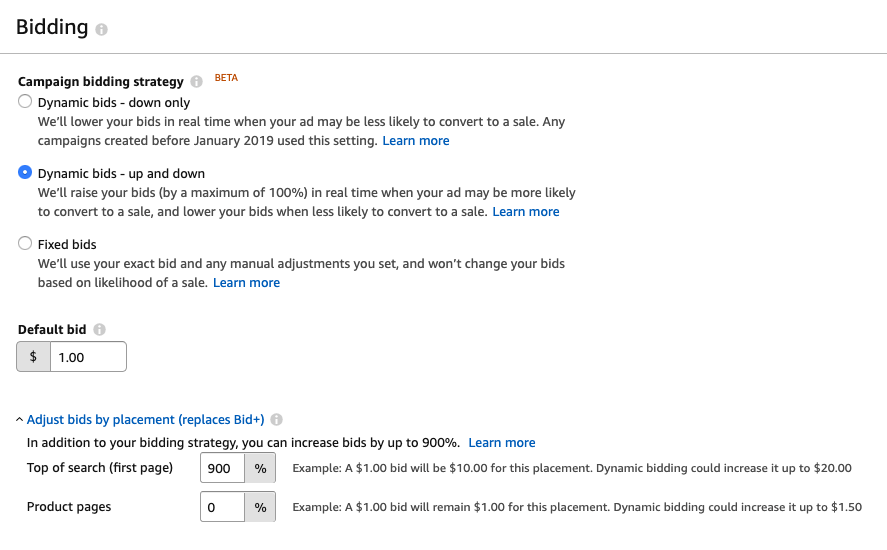
Why?
Modifying your bids for the Top of Search placement increases your chance to appear in the top ad positions. It allows you to capture the main share of impressions and removes the need to bid as high for the other ad placements.
Check out our Ultimate Guide to Dynamic Bidding Strategies and Placement Modifiers for more.
This way, you’ll maximize the likelihood that your listings receive enough impressions amid the heightened competition.
3 — Optimize your existing campaigns
Spring cleaning your PPC campaigns is just as important as optimizing your product listing.
After all, you’re spending a considerable sum of money on Prime Day, so it’s crucial that your campaigns run as efficient as possible.
Have you researched better keywords? Added negative keywords? Spotted keywords without impressions that you need to activate on your listing?
Now is the time to give your campaigns a polish
Our Guide to Campaign Optimization is here to help.
4 — Use Sponsored Brands to Guide Shoppers to Your Store
Vendors and Sellers with Brand Registry can use Sponsored Brands (previously ‘Headline Search Ads’) to funnel shoppers to a brand-specific environment.
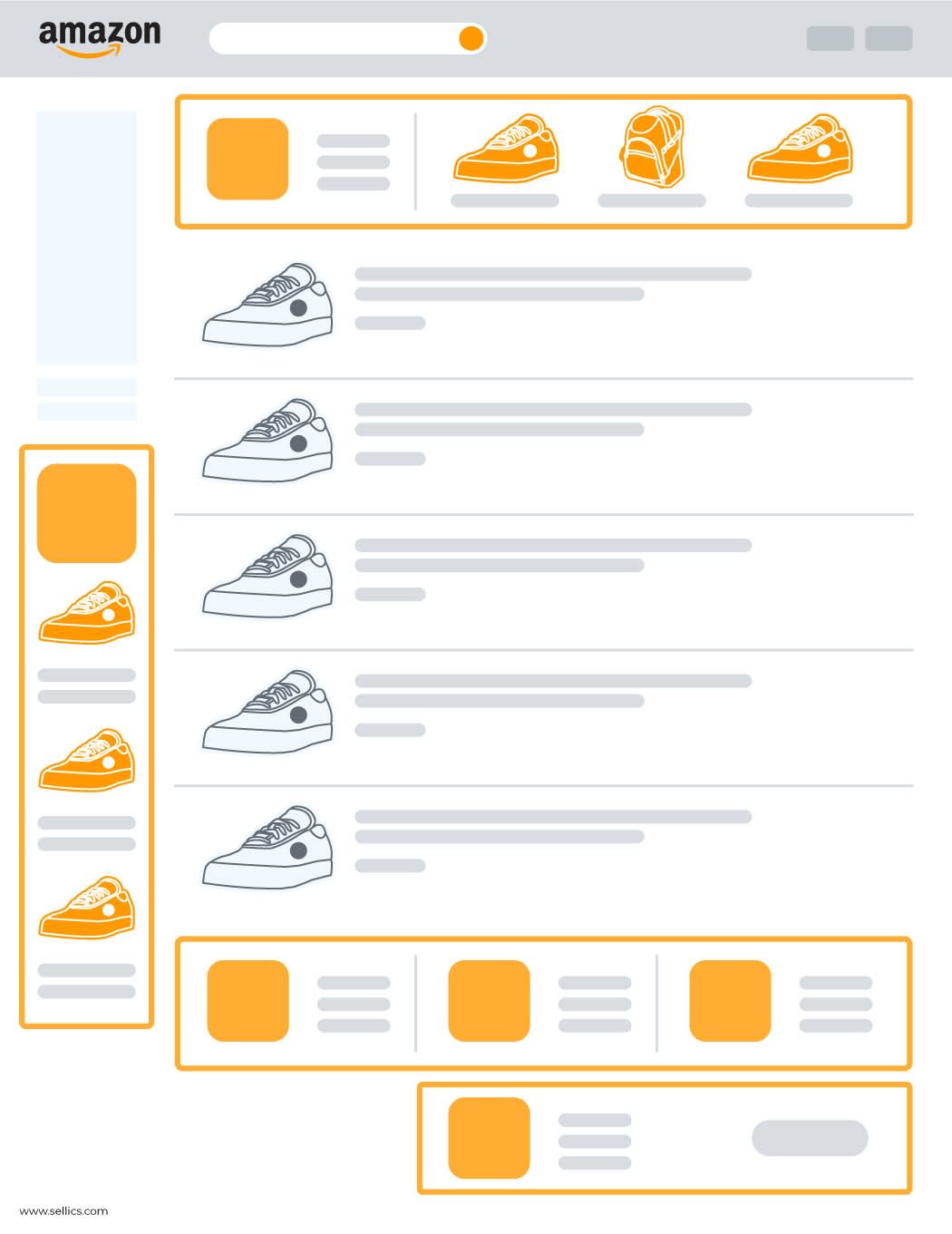
This is a very effective strategy because you can design a distinct Prime Day landing page and tailor your brand store to highlight your Prime Day specials.
As a bonus, you can easily share the brand store in your external outreach campaign via social media and email.
Guess what:
You can manage Sponsored Brands with Sellics and we've written a Beginner's Guide for Running Effective Sponsored Ads.
5 — Create a campaign explicitly for Amazon Prime Day
Please note: This strategy is only for new products or those you have not advertised yet.
Amazon advertising campaigns need time to acquire a decent quality score.
If you plan to advertise new items (or those you haven’t advertised before), we recommend you start your new campaigns about two months before an event — in this case, usually during the submission window for the Prime Day Lightning Deals.
Aiming to raise brand awareness on Prime Day can be tricky — and expensive.
Instead, we suggest you direct your advertising efforts to your products with Prime Day offers.
Shoppers are hunting for bargains — if they like your promotion, they are more likely to browse your other products and connect with your brand.
6 — Use Sellics Ad Scheduling to target peak shopping times
Please note: This strategy is only for experienced Prime Day advertisers. If you don’t know your peak times, you should promote your deals throughout the event.
If you have a limited budget and/or know when your target group is active during Prime Day, you can increase the efficiency of your ads with Ad Scheduling in Sellics.
This strategy might also be useful if you are promoting your products in a different time zone.
7 — Don’t Disappear — Keep an Eye on Your Daily Budget
On Prime Day, your campaign budgets might run dry quicker than expected. Once this happens, your ads will disappear, so make sure you’re supplying enough cash to stay visible.
If you’re worried about the expense, remember that your organic sales might also benefit from the halo effect.
For more control, you can set your ‘daily account budget’ to a fixed spending limit on Prime Day.
8 — Stock up on Inventory (Or Let Prime Day Wipe Your Shelves)
If you follow this guide, your sales will increase significantly on Prime Day — which can boost your Amazon bestseller rank (BSR), causing increased sales to continue well into the following weeks (the so-called halo effect).
Be prepared for the best-case scenario: Make sure you have enough inventory so that you don’t sell out during (or after) Prime Day and the halo effect.
Plan ahead
So much can go wrong when you ship in more product. What if your supplier can't deliver the goods, the postal service strikes or your shipment gets held at customs…
Prime Day promotions aren’t cheap. Your investment needs protection, and by stocking up on your best products, you show your customers the reliability of your brand.
9 — Spread the Word About Your Amazon Seller Prime Day Campaign
Last but not least, go the extra mile and tell everyone about your jaw-dropping deals: Use #AmazonPrimeDay and a link to your deals in email blasts, social media posts, and paid traffic.
After Amazon Prime Day — Cleaning Once the Dust Has Settled (And What to Do Next)
Immediately following Prime Day, reduce your bids and monitor your CvR and other PPC metrics closely for at least two weeks to not get caught in shoppers’ fatigue.
Experience is a harsh but illuminative teacher. Prime Day didn’t go as expected? Now you know which parts of your Amazon business need improvement in order to make the most of the rest of Q4.
The most likely pitfalls will be your inventory replenishment, using the right keywords to reach your target impressions, and optimized content to convert all that extra traffic into buying customers.
A steep increase in sales usually comes with an increase in customer engagement — be prepared to answer many more questions, but also to handle more returns and refunds.
Gradually, things will return to normal and you can reset your ad budgets and bids.
Congratulations!
You took a leap of faith — and finally invested in one of the most intense sales events of the year. Now that you know what to expect, you'll be perfectly prepared for the upcoming waves of frenzied shopping: Black Friday, Cyber Monday, and Christmas.
Next time, plan ahead with Sellics — doubling your sales has never been easier!
To get started or learn more about how Perpetua can help you scale your Amazon Advertising business, contact us at hello@perpetua.io